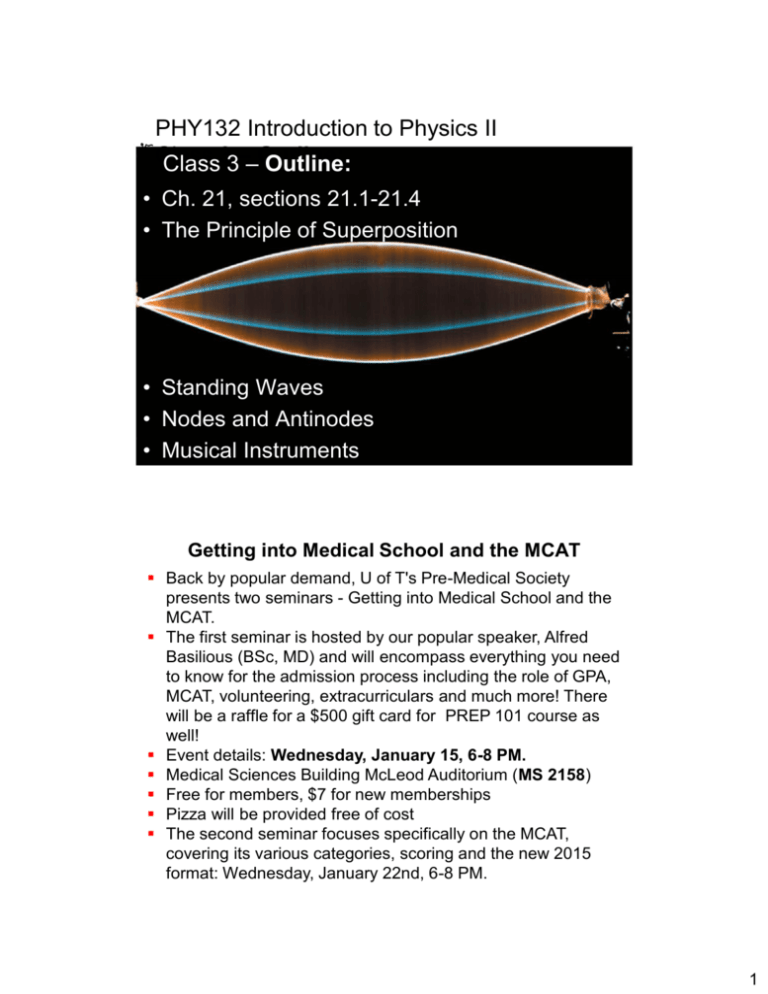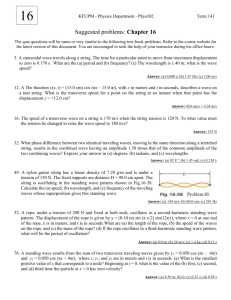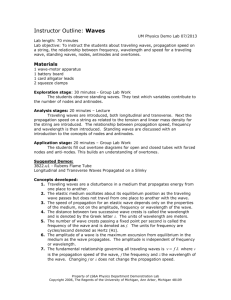PHY132 Introduction to Physics II
advertisement

PHY132 Introduction to Physics II Class Class33––Outline: Outline: • Ch. 21, sections 21.1-21.4 • The Principle of Superposition • Standing Waves • Nodes and Antinodes • Musical Instruments Getting into Medical School and the MCAT Back by popular demand, U of T's Pre-Medical Society presents two seminars - Getting into Medical School and the MCAT. The first seminar is hosted by our popular speaker, Alfred Basilious (BSc, MD) and will encompass everything you need to know for the admission process including the role of GPA, MCAT, volunteering, extracurriculars and much more! There will be a raffle for a $500 gift card for PREP 101 course as well! Event details: Wednesday, January 15, 6-8 PM. Medical Sciences Building McLeod Auditorium (MS 2158) Free for members, $7 for new memberships Pizza will be provided free of cost The second seminar focuses specifically on the MCAT, covering its various categories, scoring and the new 2015 format: Wednesday, January 22nd, 6-8 PM. 1 Class 3 Preclass Quiz on MasteringPhysics This was due this morning at 8:00am 651 students submitted the quiz on time The figure shows the displacement of a standing sound wave in a 32-cm-long horizontal tube of air open at both ends. The mode is m = 2 (count pressure antinodes) The air molecules are moving horizontally. That’s because sound is a longitudinal wave. The displacement antinodes are at 0, 16, 32 cm The pressure antinodes are at 8, 24 cm Class 3 Preclass Quiz on MasteringPhysics A guitar string is fixed at both ends. If you tighten it to increase its tension the frequencies of its vibrational modes will increase but its wavelengths will not be affected. 2 Class 3 Preclass Quiz – Student Comments… “The frequency at which I am reading the textbook has increased dramatically... Maybe because I just have too much tension in me. ” “I was wondering: if you are listening to sound from two different speakers, is there a spot you could find somewhere at the nodes of the superimposed waves where you would hear no sound?” Harlow answer: Yes, but only if both speakers were playing a single frequency (pure note). Also, you have to be at the same distance from both of them in order for the amplitudes to cancel exactly, and there needs to be no echoes interfering. In practice, it’s difficult to demonstrate this. “It is hard to absorb all this reading while watching TV.” “Don't listen to that mean student. You are an intelligent human being living a great life. Have an awesome day!” Waves in Two and Three Dimensions Particles and Waves Particles cannot occupy the same space. They collide. Waves pass right through each other. They interfere. [Animations from http://www.physicsclassroom.com/mmedia/newtlaws/mb.cfm and http://www.acs.psu.edu/drussell/demos/superposition/superposition.html ] 3 Waves in Two and Three Dimensions The Principle of Superposition If two or more waves combine at a given point, the resulting disturbance is the sum of the disturbances of the individual waves. 𝐷 = 𝐷1 + 𝐷2 QuickCheck Clicker Question 21.1 1 Two wave pulses on a string approach each other at speeds of 1 m/s. How does the string look at t = 3 s? 4 QuickCheck Clicker Question 21.2 2 Two wave pulses on a string approach each other at speeds of 1 m/s. How does the string look at t = 3 s? Reflection of Transverse Wave Pulse • A pulse traveling to the right on a heavy string attached to a lighter string • Speed suddenly increases [Animation courtesy of Dan Russell, Penn State] 5 Reflection of Transverse Wave Pulse • A pulse traveling to the right on a light string attached to a heavier string • Speed suddenly decreases [Animation courtesy of Dan Russell, Penn State] Standing Waves on a String Reflections at the ends of the string cause waves of equal amplitude and wavelength to travel in opposite directions along the string, which results in a standing wave. 6 The Mathematics of Standing Waves According to the principle of superposition, the net displacement of a medium when waves with displacements DR and DL are present is D(x, t) = DR + DL = asin(kx - w t) + asin(kx + w t) We can simplify this by using a trigonometric identity, and arrive at: D(x, t) = A(x)cos(w t) where A(x) = 2asin(kx) For a standing wave, the pattern is not propagating! Standing Wave: The superposition of two 1-D sinusoidal waves traveling in opposite directions. [Animation courtesy of Dan Russell, Penn State] 7 The Mathematics of Standing Waves The amplitude reaches a maximum value of Amax = 2a at points where sin (kx) = 1. QuickCheck Clicker Question 21.3 3 What is the wavelength of this standing wave? A. B. C. D. E. 0.25 m. 0.5 m. 1.0 m. 2.0 m. Standing waves don’t have a wavelength. 8 Node Spacing on a String Standing Waves In Chapter 20 you learned that the intensity of a wave is proportional to the square of the amplitude: I A2. Intensity is maximum at points of constructive interference and zero at points of destructive interference. 9 Standing Waves in a Microwave Oven • Microwaves are electromagnetic waves, which travel at the speed of light. • I removed the turntable from my microwave oven, and poured egg whites into a flat plate Standing Waves in a Microwave Oven • The egg whites heat faster around the edges. This is because the microwaves attenuate as they travel through the egg. • There also is a pattern of “hot spots”. These are antinodes in 3dimensional standing wave pattern 10 Standing Waves in a Microwave Oven • I measured the distance between antinodes to be about 6 cm ± 1 cm • This should be about 𝜆 2, so λ = 12 cm ± 2 cm • My microwave manual says in specifications that its cooking frequency is 2450 MHz On a string of length L with fixed end points, D(0,t) = 0 and D(L, t) = 0 Only oscillations with specific wavelengths are allowed. 11 QuickCheck Clicker Question 21.4 4 What is the mode number of this standing wave? A. B. C. D. 4. 5. 6. Can’t say without knowing what kind of wave it is. Standing Waves on a String There are three things to note about the normal modes of a string. 1. m is the number of antinodes on the standing wave. 2. The fundamental mode, with m = 1, has λ1 = 2L. 3. The frequencies of the normal modes form a series: f1, 2f1, 3f1, …These are also called harmonics. 2f1 is the “second harmonic”, 3f1 is the “third harmonic”, etc. 12 Musical Instruments Instruments such as the harp, the piano, and the violin have strings fixed at the ends and tightened to create tension. A disturbance generated on the string by plucking, striking, or bowing it creates a standing wave on the string. The fundamental frequency is the musical note you hear when the string is sounded: where Ts is the tension in the string and is its linear density. Reading Question 21.5 Clicker Question 5 The frequency of the third harmonic of a string is A. B. C. D. One-third the frequency of the fundamental. Equal to the frequency of the fundamental. Three times the frequency of the fundamental. Nine times the frequency of the fundamental. 13 Standing Electromagnetic Waves Standing electromagnetic waves can be established between two parallel mirrors that reflect light back and forth. A typical laser cavity has a length L 30 cm, and visible light has a wavelength 600 nm. The standing light wave in a typical laser cavity has a mode number m that is 2L/ 1,000,000! Standing Sound Waves • A long, narrow column of air, such as the air in a tube or pipe, can support a longitudinal standing sound wave. • A closed end of a column of air must be a displacement node. Thus the boundary conditions — nodes at the ends — are the same as for a standing wave on a string. • It is often useful to think of sound as a pressure wave rather than a displacement wave. The pressure oscillates around its equilibrium value. • The nodes and antinodes of the pressure wave are interchanged with those of the displacement wave. 14 Standing Sound Waves Standing Sound Waves 15 Displacement x and pressure graphs for the m = 2 mode of standing sound waves in a closed-closed tube. The nodes and antinodes of the pressure wave are interchanged with those of the displacement wave. 16 QuickCheck Clicker Question 21.6 6 An open-open tube of air has length L. Which is the displacement graph of the m = 3 standing wave in this tube? QuickCheck Clicker Question 21.7 7 An open-closed tube of air of length L has the closed end on the right. Which is the displacement graph of the m = 3 standing wave in this tube? 17 18 Musical Instruments With a wind instrument, blowing into the mouthpiece creates a standing sound wave inside a tube of air. The player changes the notes by using her fingers to cover holes or open valves, changing the length of the tube and thus its fundamental frequency: for an open-open tube instrument, such as a flute for an open-closed tube instrument, such as a clarinet In both of these equations, v is the speed of sound in the air inside the tube. Overblowing wind instruments can sometimes produce higher harmonics such as f2 2f1 and f3 3f1. 19 QuickCheck Clicker Question 21.8 8 At room temperature, the fundamental frequency of an open-open tube is 500 Hz. If taken outside on a cold winter day, the fundamental frequency will be A. Less than 500 Hz. B. 500 Hz. C. More than 500 Hz. Practicals Begin This Week!! (they actually began today!) • Check “My PRA Group” on the portal page for this course to see what room you go to. • Don’t miss it! 20 Before Class 4 on Wednesday • Please read Knight Ch. 21, sections 21.5-21.8 (finish the chapter) • Please do the short pre-class quiz on MasteringPhysics by Tuesday evening. • Something to think about: What is “constructive interference”? How can you interfere with something and increase its strength? 21








